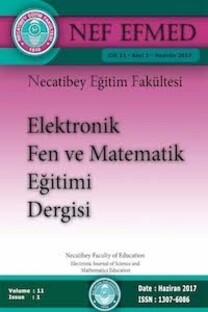Dinamik Geometri ile Keşif, Varsayım ve İspat Sürecinde Öğretmenin Rolü
Dinamik geometri, sürükleme, ölçme, üçgenin yardımcı elemanları, Didaktik durumlar teorisi, Ortaokul 7. sınıf
Exploring, Conjecturing and Proving with Dynamic Geometry Software: a case study
Dynamic geometry software, dragging, measuring, auxiliary elements of a triangle, ,
___
- Ainsworth, S. (2008). How should we evaluate multimedia learning environments?. In Understanding multimedia documents (pp. 249-265). Springer US.
- Arzarello, F., Olivero, F., Paola, D. et Robutti O. (2002) A cognitive analysis of dragging practises in Cabri environments. Zentralblatt für Didaktik der Mathematik 34, 66–72
- Baccaglini-Frank, A., & Mariotti, M.A. (2010) Generating Conjectures in Dynamic Geometry: the Maintaining Dragging Model. International Journal of Computers for Mathematical Learning, 15(3), 225-253.
- Balacheff N. (1988) A study of students' proving processes at the junior high school level. In: Second UCSMP international conference on mathematics education. Chicago: NCTM.
- Bintaş, J., Ceylan, B., & Dönmez, O. (2006). Dinamik geometri yazılımları aracılığıyla ispat yoluyla öğrenme, Eğitimde Çağdaş Yönelimler–3 Yapılandırmacılık ve Eğitime Yansımaları Çalıştayı (29 Nisan 2006). İzmir: Tevfik Fikret Okulları.
- Brousseau, G. (1997). Theory of Didactical Situations in Mathematics : Didactique des mathématiques, 1970-1990. Kluwer Academic Publishers (Springer).
- Chazan, D. (1993) High school geometry students' justification for their views of empirical evidence and mathematical proof. Educ Stud Math 24, 359–387
- Christou , C., Mousoulides, N., Pittalis, M., & Pitta-Pantazi, D. (2004). Proofs through Exploration in dynamic geometry environments. International Journal of Science and Mathematics Education (2004) 2: 339–352.
- Christou , C., Mousoulides, N., Pittalis, M., & Pitta-Pantazi, D. (2004). Proofs through Exploration in dynamic geometry environments. International Journal of Science and Mathematics Education (2004) 2: 339–352.
- Christou, C., Mousoulides, N., Pittalis, M., & Pitta-Pantazi, D. (2005). Problem solving and problem posing in a dynamic geometry environment. The Montana Mathematics Enthusiast (TMME), 2(2), 125-143.
- De Villiers, M. (2003) Rethinking Proof with Sketchpad 4. Emeryville, CA: Key CurriculumPress,
- Edwards, L. (1997) Exploring the territory before proof: Students' generalizations in a computer microworld for transformation geometry. International Journal of Computers for Mathematical Learning, 2, pp. 187-215.
- Erdoğan, A. (2016). Didaktik durumlar teorisi. E. Bingölbali, S. Arslan, ve İ. Ö. Zembat (Ed.), Matematik eğitiminde teoriler içinde (s. 413-430). Ankara: Pegem.
- Güven, B., & Karataş, İ. (2003). Dinamik geometri yazılımı cabri ile geometri öğrenme: Öğrenci görüşleri. The Turkish Online Journal of Educational Technology – TOJET , 2 (2).
- Healy, L. & Hoyles, C. (2001). Software tools for geometrical problem solving: Potentials and pitfalls. International Journal of Computers for Mathematical Learning, 6, 235–256.
- Healy, L., Hoyles, C. (2002) Software Tools for Geometrical Problem Solving: Potentials and Pitfalls. International Journal of Computers for Mathematical Learning 6, 235–256
- Işıksal, M., & Aşkar, P. (2003). Elektronik tablolama ve dinamik geometri yazılımını kullanarak çalışma yapraklarının geliştirilmesi. İlköğretim Online, 2(2).
- Jones, K. (2000). Providing a foundation for a deductive reasoning: students’ interpretation when using dynamic geometry software and their evolving mathematical explanations. Educational Studies in Mathematics, 44(1-2), 55–85.
- Jones, Keith (2000) Providing a foundation for deductive reasoning: students' interpretations when using dynamic geometry software and their evolving mathematical explanations. Educational Studies in Mathematics, 44 (1-2), 55-85
- Köse, N. Y., & A. Özdaş (2009). İlköğretim 5. sınıf öğrencileri geometrik şekillerdeki simetri doğrularını cabri geometri yazılımı yardımıyla nasıl belirliyorlar? İlköğretim-Online, 8(1), 159-175.
- Laborde C. (2005) The Hidden Role of Diagrams in Students’ Construction of Meaning in Geometry. In: Kilpatrick J., Hoyles C., Skovsmose O., Valero P. (eds) Meaning in Mathematics Education. Mathematics Education Library, vol 37. Springer, New York, NY
- Laborde, C. (2001). Integration of technology in the design of geometry tasks with cabri-geometry. International Journal of Computers for Mathematical Learning, 6(3), 283–317.
- Lagrange, J.-B., & Ozdemir Erdogan, E. (2009). Teachers’ emergent goals in spreadsheet-based lessons: analyzing the complexity of technology integration. Educational Studies in Mathematics, 71(1), 65–84
- Marrades, R., & Gutiérrez, A. (2000). Proofs produced by secondary school students learning geometry in a dynamic computer environment. Educational Studies in Mathematics, 44, pp. 87-125.
- Olivero, F., & Robutti, O. (2007). Measuring in dynamic geometry environments as a tool for conjecturing and proving. International Journal of Computers for Mathematical Learning, 12 (2), 135 - 156.
- Pandiscio, E. A. (2002). Alternative geometric constructions: Promoting mathematical reasoning. Mathematics Teacher, 95(1), 32–36.
- Soldano, C. & Arzarello, F. (2016). Learning with touchscreen devices: game strategies to improve geometric thinking. Mathematics Education Research Journal, 28, 9–30.
- Straesser, R. (2001). Cabri-geometre: Does Dynamic Geometry Software (DGS) change geometry and its teaching and learning?, International Journal of Computers for Mathematical Learning, Vol. 6, pp.319-333.
- Vadcard L. (1999) La validation en géométrie avec Cabri-géomètre : mesures exploratoires et mesures probatoires. Petit X 50, 5-21
- Yerushalmy, M. (2005). Challenging known transitions: Learning and teaching algebra with technology. For the learning of Mathematics, 25(3), 37-42.
- ISSN: 1307-6086
- Yayın Aralığı: 2
- Başlangıç: 2007
- Yayıncı: Balıkesir Üniv. Necatibey Eğitim Fak.
Eda ERDAŞ KARTAL, Günkut MESCİ, Mustafa YILDIZ
Rehberlik Öğretmenlerinin Bakış Açısıyla Okul Rehberlik Hizmetlerinde Yaşanan Sorunlar
Matematikte Bilimsel Süreç Becerileri: Test Geliştirme Çalışması
Ayhan YILMAZ, Sinem DİNÇOL ÖZGÜR
